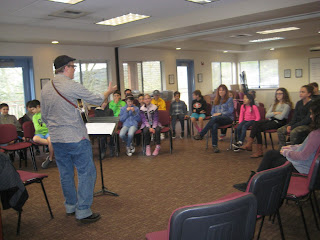Then, he proceeded to break down the sounds to show how the klezmer sound is produced. First, he played the major scale that we are all familiar with in western music (the do, re, mi scale). Then he introduced the Freigish scale (Phrygian scale in English, and Ahava Rabah in Hebrew):
Once we understood how the klezmer sound is produced, Dave introduced us to a rhythm or beat frequently used in klezmer music - the hora:
It's not enough to learn about the hora rhythm in words - Dave got everyone involved by teaching us to clap our hands and stomp our feet to the hora beat. Trust me, you really have to concentrate to get the hands and feet coordinated!
The hour flew by, and just as it was time to leave for tefillah (or to go home for second session students), Dave took out his mandolin (which was made in 1937!), shared its structure, and then showed us how it's played:
He finished his presentation by playing the Yiddish song, "Bei Mir Bist Du Shayn" ("You're Beautiful to Me"), which became a hit in the United States in the 1940's, sung by the Andrews Sisters. Sadly, my camera was almost out of battery, and I knew I had to save some for Creative Tefillah. (Yes, I promise to enter the 21st century and get an IPhone and join Facebook - someday!)
A big thank you goes to Dave and to the Tam Program for sharing this rich Yiddish culture with our students. Now we can all truly appreciate our own Isaiah "Kleztones" when they play for us.
As I mentioned, yesterday we held a Creative Tefillah between the sessions, and one of the sixth graders leading it was our own Joey. The theme the students chose to tie together the prayers we chanted was the Super Bowl, since it was played yesterday afternoon. (Congratulations to the Patriots - and a very big congratulations to the Patriots' receiver, Julian Edelman who performed amazingly in the game! Just before tefillah ended, Rabbi Miller shared a video made by Julian when he visited Israel in 2015.)
Here's Joey introducing the "Mi Chamocha" song:
And here he is again, introducing the Silent Prayer section of the Amidah:
(and my camera's battery died just as he finished!)
This coming Tuesday and Wednesday we'll be preparing two recipes. First, as part of our scheduled cooking session with Karen (on Tuesdays) and Stephanie (on Wednesdays), we'll be preparing Date Chews in honor of the Tu Beesh'vat holiday which is this coming Friday evening and Saturday. Then, after tefillah and hafsaka (recess), the Edot students will prepare poppy seed cookies in our classroom, as part of our Ashkenazeem unit of study. Once they're baked (after class is over), I'll prepare special bags filled with enough cookies for the entire family for the students to bring home the following Sunday (when we'll be decorating wimpels!) Stay tuned!
*In case you aren't familiar with the title of this post, (Yidl Mitn Fidl), it's from a movie made in the 1930's starring the Yiddish actress Molly Picon.

No comments:
Post a Comment